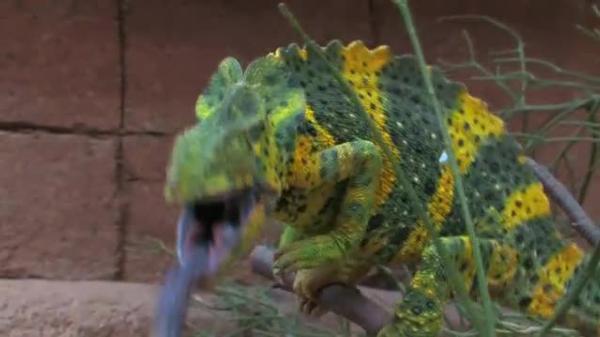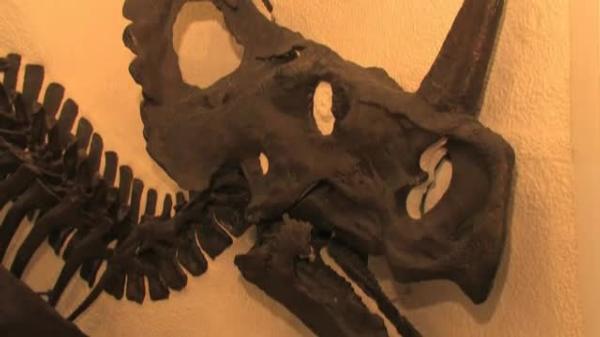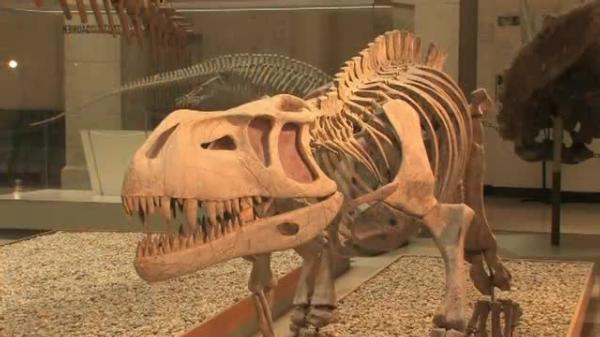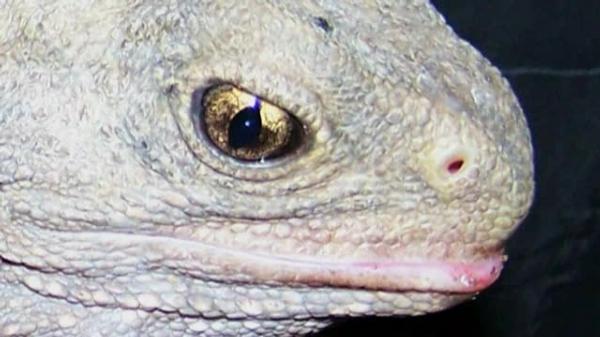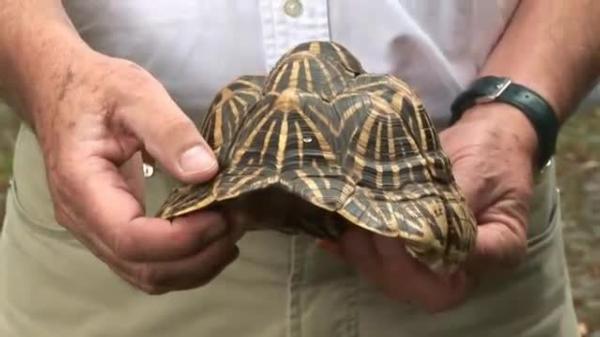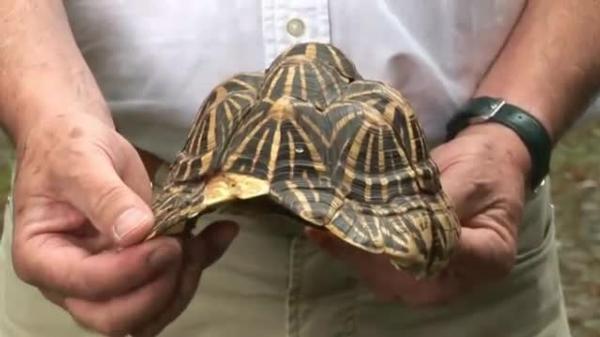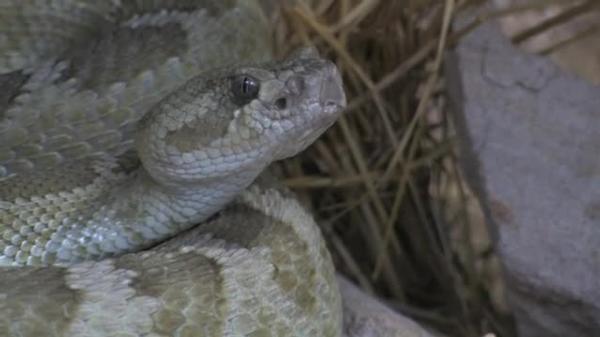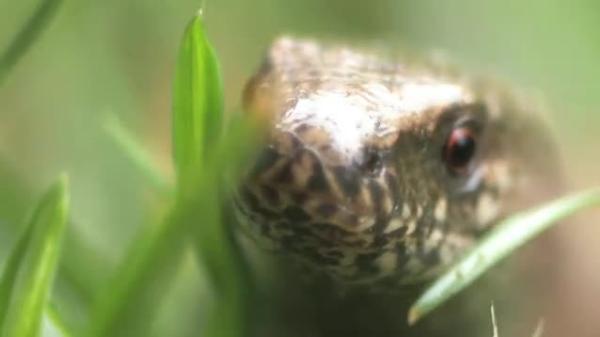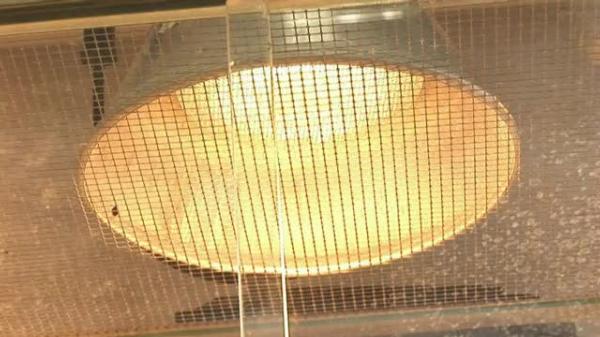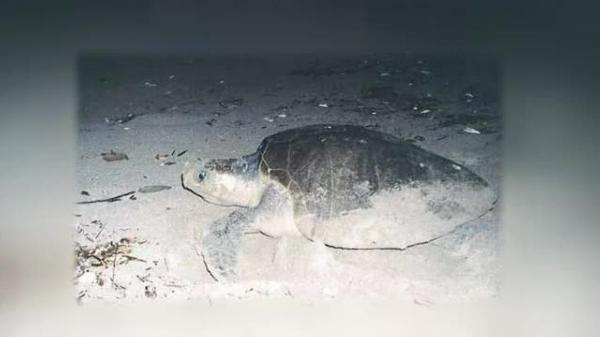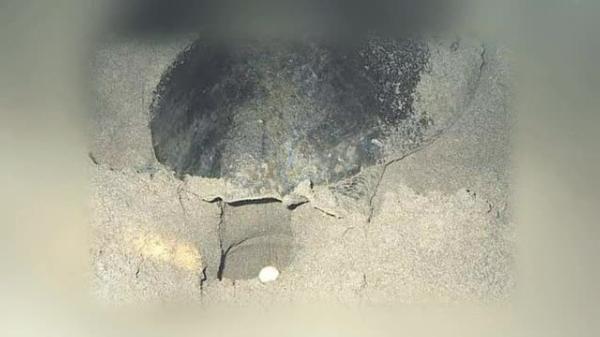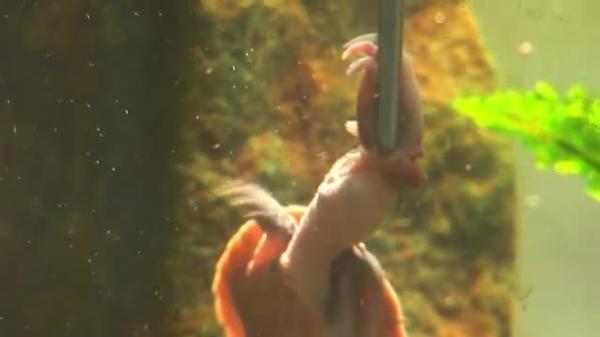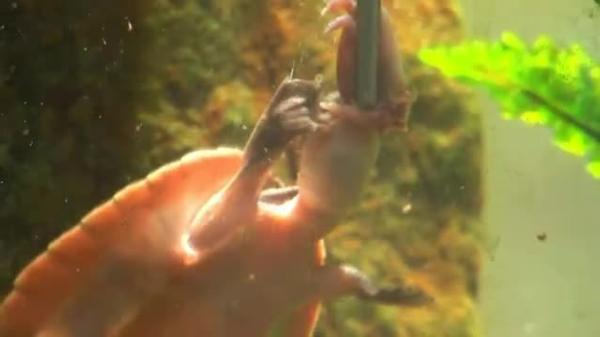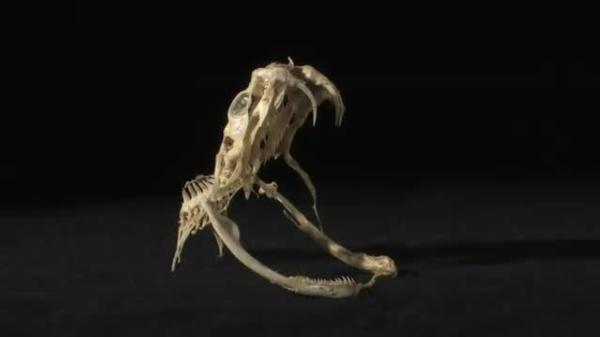Reptilien
Wirbeltiere 3

Reptiles

1. Evolution 1.1 The Ancestors of Reptiles When talking about reptiles many of us think of the extinct ancestors of this category of vertebrates, the dinosaurs. The first reptiles appeared about 260 million years ago and dominated our earth for more than 160 million years. When, 200 years ago, the term reptile was coined, many fossilized forms were still unknown. As we know today, the prehistoric reptiles didn't just crawl, but could run, swim, climb and fly. This is the skeleton of a bradysaurus baini. It lived 252 million years ago and belongs to the primeval reptiles, dating back to the Upper Permian period. The position of its four legs reminds vaguely of tortoises. Similarly slow was its locomotion, which led to its name, for 'brady' is derived from the Greek word 'bradys' and means 'slow'. Another ancestor of the dinosaurs is this predator originating from Brazil. It lived 235 million years ago and its build is, contrary to that of the bradysaurus, long-legged and slim. Giant reptiles like this plateosaurus, which was found in Bavaria and can be admired in the palaeontological museum of Munich like all other skeletons shown here, also lived in Central Europe 220 million years ago. In spite of its size, this monster with the relatively small teeth fed exclusively on plants. This small predatory saurian was also found in Germany and shows that there were not only big dinosaurs. Compsognathus longipes had the size of a chicken, hollow bones like a bird and was, 150 million years ago, with its weight of only 3.5 kilos an extremely fast specimen of its kind. It ran on two legs and its anatomy reminds more of a bird, such as the archaeopteryx, than of a reptile. The ancestors of our present-day reptiles dominated, apart from land and water, also the air.Pterodactyls like this ramphorynchus fed on insects and fish and have often been found fossilized in the quarries of Solnhofen.Their heyday was during the Jurassic and Cretaceous periods. Among the pterodactyls there were specimens of various sizes, just like among saurians living on land. From the size of a sparrow to a wing span of 15 metres. 1.2 The Tuatara This lizard originating from New Zealand is the only dinosaurwhich hasn't changed in its distinctive marks for millions of years until today; so to speak a living fossil! In the Maori language it is called tuatara, because this means bearing spines. The tuatara is classified scientifically under the order of the sphenodontida. Contrary to the lizards, which generally love warmth the tuatara develops its full activity at a temperature of 9 - 14°C. The amateur would call this animal simply lizard, thus classifying it correctly among the reptiles. By what features do we actually recognize a reptile? 1.3 Reptiles are Endangered ( 8 photos) 2. Common Marks of Reptiles 2.1 Skin Covered in Scales The order of the tortoises belongs to the most original reptiles. Everyone recognizes these animals by their shell. Tortoises bear a double coat of shell. Under a thin plate of horn there is a strong bone armour grown together with the body skeleton, thus forming a bony capsule, the shell. Reptiles wear a coat of scales. The scales consist of horn and form a visible protection. The size, arrangement and depth of the scales vary from species to species. The horny epidermis of reptiles is dry and without glands. So reptiles cannot perspire and give off surplus body heat through evaporation. This applies also to the skin of the iguana. It protects it like all reptiles against dehydration. This animal looks like a snake at first glance. However, the scales on the ventral side look different from those of a snake. The scales on its stomach and its back are largely the same. It is a slowworm, counting among the lizards; mind you: a lizard without legs! Also on this lizard, this spiny agama, we look in vain for abdominal sternites. As a snake's epidermis can't grow, it is shed as a whole from time to time. This thrown off skin is called slough. The lizards' epidermis is shed only in particles. Underneath, fresh skin of a deeper colour becomes visible. The horny scales of the crocodile are very thick; we also call it a crocodilian. Five webbed fingers in front and claws on the first three fingers. At the rear there are only four toes, and webs and claws on the first three toes as well. These blunt front claws are not meant for climbing but for scratching and digging. The weather-beaten hide of many reptiles is a much coveted material for the production of the most various leather goods. But as many reptiles are threatened by extinction, we should do without these products. 2.2 Sense Organs As various as a reptile's physique is, as differently shaped are also its sense organs. A snake's eye is clearly recognizable. It is spherical and having no lid cannot be shut. Its pupils can be slits, are formed either horizontally or often vertically as with this rattle snake, or round as with this West African mamba. Snakes with round pupils are mostly diurnal, those with the narrow pupils nocturnal.Thus they protect the delicate retina from daylight. The form of the pupils doesn't indicate in any way whether the snake is poisonous or not. More important than sight is, especially for noctunal reptiles and those creeping mostly close to the ground, a sense for chemical stimuli. Although snakes as well as lizards have nostrils, these are mostly only used for breathing. The tongue picks up the molecules in the air and transports them to an opening in the velum called Jacobson's organ, which especially with snakes and lizards is of eminent importance when they take up smells . The sense of smell is actually the most important sense for tracking down prey as well as for finding a mate. Especially snakes must rely on vision and smell in orientation, because they lack any sense of hearing as we have it. Outwardly there are no recognizable ear holes and we can safely assume that snakes are deaf. This lack is compensated for by their sensitivity to the slightest vibration of the ground. Lizards, however, clearly react to noises and we easily recognize their eardrums behind their eyes. Lizards' eyes can be shut by lids like ours. Like birds and also sharks some reptiles, for example crocodiles, have a third lid. The nictitating membrane. It is pulled from the inner corner across the eye. Remnants of a nictitating membrane can even be recognized in the human eye. Rattle snakes belong to the family of pit vipers. The name is derived from the two clearly recognizable depressions between eyes and nostrils.These about 3-mm-wide pit organs are supplied with a membrane that can perceive a difference in temperature of 3/1000°C. The arrangement of the pit organs enables the rattle snake to locate the exact direction in which to find a warm-blooded prey. It is presumed that pit vipers can see their prey like the picture on a thermal imaging camera. 2.3 Reptiles are Vertebrates More than 6000 species and that is 96% of all reptiles belong to the order of the so-called scaled reptiles. By far the greatest variety of species of all reptiles on earth is found with lizards and snakes. There are a lot of lizards without legs, though. Snakes evolved from lizards. Proof of this are the remnants of hind legs still visible in some boas like this boa constrictor. We recognize small claws to the left and to the right of the cloaca. They are continued within the body in the form of regressed bones of hind legs and pelvis. Related to the family of lacertilia are the skinks. Their glossy scales are tightly packed and smooth. The outward adaptation to a wriggling locomotion is clearly recognizable with the skinks.They make us understand how the evolution of snakes may have proceeded. Reptiles are thus vertebrates, no matter whether they have arms and legs or not. With this tortoise we only identify the short tail and the neck of the spinal column. All other parts of the tortoise have grown together with the shell. Arm and leg bones are homologous in their structure to those of other species of vertebrates. 2.4 Thermoregulation Keeping reptiles in a terrarium requires a lot of knowledge about he needs of these animals. More than birds or mammals, reptiles are dependent on specific physical environmental factors. The red light lamp above the terrarium provides the necessary heat without which reptiles cannot develop their physical abilities to the full. All reptiles lack subcutaneous fat, fur or plumage, which prevent body heat from escaping. Spread and variety of reptiles increase considerably in tropical and subtropical areas. Even in inhospitable deserts many reptiles succeed in surviving. Reptiles adapt their body temperature to outside temperatures. They are called cold-blooded. Reptiles in the moderate climatic zone must avoid frost, which is life threatening to them. In winter they migrate to frost-free habitats. 2.5 Indigenous Reptiles (10 photos) 3. Reproduction 3.1 Oviparous and Viviparous Reptiles Reptiles don't lay their eggs in water like their amphibious ancestors, but on land. A tight parchment-like coat protects them against dehydration. Also turtles like this one lay their eggs on land. However, the up to 150 eggs cannot do without some humidity, they would shrivel. But it is due to the fact that about 250 million years ago reptiles succeeded in laying eggs rich in yolk and protected by a soft shell that they eventually came to live on land. The egg structure and the ways the embryos develop differentiate the reptiles and their descendants, the birds, from fish and amphibians, whose eggs can only develop in water. The shell of a reptilian egg isn't covered by a hard chalky coat like a bird's egg. Its shell is firm but not hard, it's supple instead. Both the hatching of the eggs and the care of the brood after hatching are a huge exception with reptiles. One of these exceptions are the crocodiles. The female crocodiles watch their eggs and as soon as they hear their offspring croaking in the still unopened eggs, they open the nest and carry their young ones in their mouths to the water. For 6 to 8 weeks the young ones remain in the care of their mother or even of both parents. As a rule reptiles are precocial animals, that means they leave the egg and are capable of surviving on their own. Apart from a few exceptions brood care and raising of the young animals as we know it from many bird species, for example with these spitted woodpeckers, doesn't exist with reptiles. Snakes and lizards manage without their parents' help after hatching. This, however, entails also great dangers, for the little ones are welcome prey for other animals. Many reptiles often make up for these losses by a high number of offspring. A lot of crocodiles, which, interestingly enough, are the nearest relatives of birds, build nests as they do. They tear off and scrape together plants, which they mix with earth and lay out conical 70- to 100-centimetre-high nests with a diameter of about 200 centimetres. Depending upon the species 10 to 100 eggs are laid, which correspond in size to those of hens or geese. The female remains close to the nest to defend it, if need be, against predators such as dragons, birds or bears which have their eyes on the eggs. 4. Food 4.1 Herbivores and Carnivores Tortoises, feeding exclusively on plants, are the exception among the reptiles. Tortoises eat grass, leaves and squashy fruit. Their relatives living on or in the water mostly prefer meat. The majority of reptiles count among the predators, which feed on mammals but also on other reptiles.Tortoises with their bulging curved shell can be distinguished easily from the slightly flatter shell of the pond turtle and the clearly flattened shell of the turtle. Tortoises don't have teeth to bite off and crush their food, but hard jaw bones. Like all other reptiles tortoises don't chew but swallow their prey whole or in one piece. While tortoises manage without teeth, crocodiles are lavishly equipped with them. The chameleon, specialised in catching insects, shows a technique which is singular in the realm of reptiles to get at its food. Well camouflaged, as it can even adapt the colour of its scales to the prevailing surroundings, it doesn't budge, keeping a lookout for a suitable prey with its equally singular eyes. Its eyes, which can move independently, are encircled by thick ingrown lids, which, conically shaped, leave only space for a small pupil. Like a harpoon fastened to a line the tongue shoots out. It can become longer than half the body length and has a ring-shaped depression at its widening tip, with which it can hold on to its prey in order to convey it quickly into its mouth. 4.2 Poisonous Snakes and Constrictors Like almost all reptiles snakes, too, are ambush predators. Well camouflaged they wait patiently for the right moment for a good kill. Similarly to the predatory fish they must snatch, hold and swallow their prey with their mouths, without arms, hands or claws. That's why teeth are indispensable. As we can recognize clearly their teeth are very pointed and bent backwards, so that the prey, once grabbed, cannot escape. The mouse is swallowed with each side of the jaw alternatingly pulling the prey down the throat. A poisonous snake additionally has fangs in its upper jaws. These are fed by a venom gland. Number, structure and length of fangs differ from species to species. The venoms have different effects depending upon their chemical composition. For example, the venom of this rattle snake destroys the synapses, thus paralyzing respiration. Frequently the venom doesn't only help to paralyze or kill the prey, but definitely supports the digestive system. Carnivorous reptiles swallow their prey complete, with bones and claws. It takes about one week until the rat, swallowed by a snake about a week ago, is completely digested and its remains excreted. Among the best known snakes are the boas. They impress not only by their length and weight, but especially by their pretty patterns and their shining skin covered in scales.

